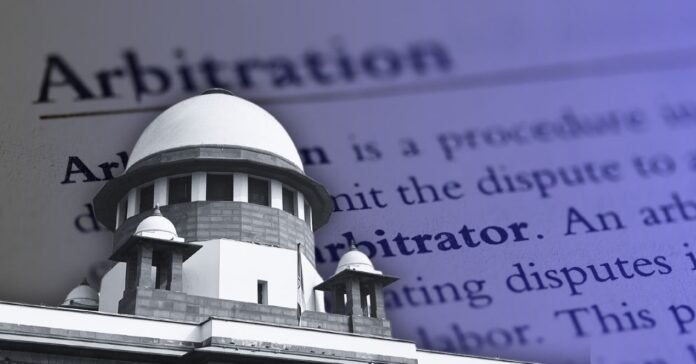The Supreme Court holds that mere use of the word “arbitration” in a clause does not suffice to create a binding arbitration agreement; clear intention is required.
The Supreme Court of India has reiterated that the use of the term “arbitration” in a contract clause is not enough to trigger a binding arbitration agreement unless the parties clearly agreed to that route.
In a landmark judgment handed down earlier this month, the Supreme Court reaffirmed a fundamental principle of arbitration law in India: simply having the word “arbitration” (or “arbitrator”) in a contractual clause does not automatically create a valid arbitration agreement. The Bench upheld the decision of the Punjab & Haryana High Court which refused to refer a dispute to arbitration for want of a clear, binding agreement to arbitrate.
Facts of the case
The dispute arose out of a commercial contract between two parties, whereby one party sought to invoke a clause — titled “Arbitration” or “Dispute Resolution / Arbitration” — to trigger an arbitral process. The clause, however, provided that the parties would first negotiate in good faith; if that failed, mediation would follow; only thereafter did the clause mention that “any dispute arising out of or relating in any way to this Agreement shall be resolved by arbitration through senior management comprising the respective Chairmen of the parties; and if after 15 days of such “arbitration”, the complaining party shall seek remedies through courts of law”. Verdictum+2Sci API+2
On an application under Section 11(6) of the Arbitration and Conciliation Act, 1996 (A&C Act), the High Court held that the clause did not amount to an arbitration agreement because it lacked the essential element of present consent to arbitrate. The Supreme Court, while hearing the appeal, affirmed this, emphasising that under Section 7 A&C Act an arbitration agreement must show:
- an agreement between parties to refer disputes to arbitration (either before or after the disputes arise);
- the disputes must relate to a legal relationship; and
- the agreement must be in writing. ABCAus+2Verdictum+2
What the Supreme Court held
The Court held that the mere use of the word “arbitration” or “arbitrator” is not clinching or decisive. The essence lies in whether the clause exhibits ad idem (meeting of minds) that the parties intended their disputes to be resolved by arbitration and to be bound by the decision of the arbitral tribunal. Verdictum+1
Some of the key observations were:
- The clause in question employed language such as “may be sought through arbitration …” or required further consensus/choice before arbitration could be triggered. Such enabling or optional language is insufficient. Sci API+1
- The clause provided for senior management (Chairmen of parties) rather than a neutral third‐party arbitrator; the Court noted that arbitration ordinarily contemplates a neutral tribunal. Verdictum+1
- Post-notice correspondence or non-denial of the invocation of arbitration cannot cure an original absence of intent to refer disputes to arbitration. ABCAus+1
Accordingly, the Supreme Court dismissed the appeal, affirming that the agreement did not constitute an “arbitration agreement” under Section 7 and hence there was no mandate to refer the dispute to arbitration under Section 11 of the A&C Act. Sci API+1
Why this matters
This decision holds significance for parties drafting contracts, legal practitioners and in-house counsel. The key take-aways are:
- Precision in drafting is essential. Simply labelling a clause as ‘Arbitration’ or using the word ‘arbitration’ is not enough; the clause must demonstrate a clear, binding commitment to arbitrate.
- No ambivalence allowed. Words like “may”, “can”, “if the parties so decide” reflect optionality and not a binding submission to arbitration. Such language is likely to be rejected as not constituting an arbitration agreement. SCC Online+1
- Intent matters more than form. The Court emphasised substance over form. An arbitration agreement is the “creature of a contract” and hinges on the underlying intention of the parties. Verdictum
- Consultation vs binding commitment. A clause that contemplates negotiation, mediation or in‐house settlement before arbitration may indicate an intent not to bind the parties to arbitration at an early stage.
- Clarity for enforcement. For parties seeking to invoke arbitration under Section 11 of the A&C Act, the clause must survive prima facie scrutiny: if it fails at that threshold, the court may refuse to refer the dispute. Sci API
Practical guidance
In light of this ruling, contract-drafters and parties should focus on:
- Ensuring the clause says something like: “The parties agree that all disputes arising out of or in connection with this Agreement shall be finally resolved by arbitration in accordance with …” rather than optional language.
- Identifying a neutral arbitral tribunal or institution, or specifying a clear mechanism for appointing one, rather than leaving the appointment to party officials or senior management.
- Avoiding residual court jurisdiction clauses that undermine arbitration by stating that “in the alternative” parties may resort to court if arbitration fails.
- Keeping in mind that any indication that the clause is mere “enabling” or “permissive” may be held not to constitute a binding arbitration agreement.
- Reviewing existing contracts and dispute-resolution clauses to ensure they reflect the present threshold intent to arbitrate; otherwise, even invoking arbitration may be dismissed at the outset.
Conclusion
The Supreme Court’s ruling provides clarity on a recurrent area of ambiguity in Indian arbitration law. Parties cannot rely merely on the presence of the word “arbitration” in a contract. What matters — and what the Court will probe — is whether the clause reveals a definitive, binding agreement to refer disputes to arbitration and to be bound by the decision of the tribunal. The intention must be clear and present. Without this, the courts will refuse to compel arbitration.
For further insights into arbitration jurisprudence, see earlier coverage on The Legal Observer’s national news section and analysis in our views/insight category. And for multimedia content, do visit The Legal Observer on YouTube.





